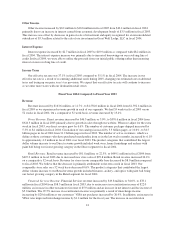Cabela's 2005 Annual Report Download - page 60
Download and view the complete annual report
Please find page 60 of the 2005 Cabela's annual report below. You can navigate through the pages in the report by either clicking on the pages listed below, or by using the keyword search tool below to find specific information within the annual report.Cash used in financing activities was $29.0 million in fiscal 2005 as compared with cash provided of $135.8
million in fiscal 2004. The difference in cash used was primarily the proceeds from our initial public offering,
which raised net proceeds of $114.2 million in fiscal 2004. In fiscal 2005, our first principal installment of $25.0
million was due on our private placement of debt that was issued in 2002. The change in unpresented checks net
of bank balance used cash of $10.9 million due to timing of when checks cleared our bank. The change in bank
time deposits also used cash of $10.1 million as we had more time deposits mature than in fiscal 2004.
Cash provided by financing activities was $135.8 million in fiscal 2004 as compared with $40.4 million in
fiscal 2003. This increase in financing activities is primarily attributable to our initial public offering, which
raised net proceeds of $114.2 million. In addition, our debt payments decreased by $15.5 million primarily due to
an early payoff of a note that occurred in 2003. In addition, we had a decrease in cash paid for our employee
savings plan of $7.9 million. We terminated this plan in 2003 and paid most of the balances by the end of fiscal
2003. Finally, there was an increase in the time deposit activity at our bank, as we sold additional time deposits
of $6.8 million. These increases to our financing activities were offset by a net decrease in activity in our
employee stock options of $48.9 million. This includes the amount of stock exercised and paid for by our
employees and stock that was subsequently repurchased by us from our employees. This decrease in activity is
primarily due to activities related to the recapitalization transaction that occurred in 2003, whereby a significant
number of employee stock options were exercised.
As of December 31, 2005, we had entered into material commitments in the amount of $132.7 million for
fiscal 2006 and $150.8 million for fiscal 2007 for estimated capital expenditures and the purchase of future
economic development bonds in connection with the construction and development of new destination retail
stores. In addition, we are obligated to fund $23.1 million of future economic development bonds relating to
expansion of our distribution center in Wheeling, West Virginia in fiscal 2006.
Retail Store Expansion
Significant amounts of cash will be needed in order to open new destination retail stores and implement our
retail growth strategy. Depending upon the location and a variety of other factors, including store size and the
amount of public improvements necessary, and based upon our prior experience, opening a single large-format
store may require expenditures of $30 million to $50 million. This includes the cost of real estate, site work,
public improvements such as utilities and roads, buildings, equipment, fixtures (including taxidermy) and
inventory.
Historically, we have been able to negotiate economic development arrangements relating to the
construction of a number of our new destination retail stores, including free land, monetary grants and the
recapture of incremental sales, property or other taxes through economic development bonds, with many local
and state governments. We are able to negotiate these agreements as we generally have located our destination
retail stores in towns and municipalities that do not have a large base of commercial businesses. We design our
destination retail stores to provide exciting tourist and entertainment shopping experiences for the entire family.
Our destination retail stores employ many people from the local community, draw customer traffic from a broad
geographic range and serve as a catalyst for the opening of additional retail businesses such as restaurants, hotels
and gas stations in the surrounding areas. We believe all of these factors increase the revenue for the state and the
local municipality where the destination retail store is located, making us a compelling partner for community
development and expansion. The structure, amounts and terms of these arrangements vary greatly by location.
Grants. Under various grant programs, state or local governments provide funding for certain costs
associated with developing and opening a new destination retail store. We generally have received grant funding
in exchange for commitments, such as assurance of agreed employment and wage levels at our destination retail
stores or that the destination retail store will remain open, made by us to the state or local government providing
the funding. The commitments typically phase out over approximately five to ten years, but if we fail to maintain
the commitments during the applicable period, the funds we received may have to be repaid or other adverse
48
























